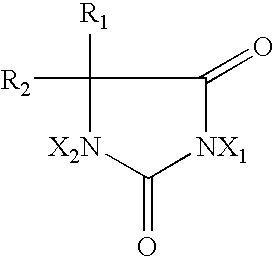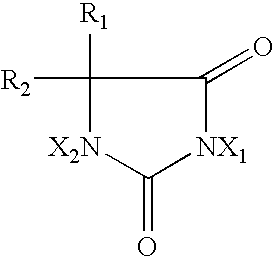Hydantoin-enhanced halogen efficacy in pulp and paper applications
a technology of hydantoin and halogen, which is applied in the direction of biocide, water/sewage treatment by oxidation, and addition of slime-control agents, etc. it can solve the problems of affecting the biocidal efficacy of such compounds, unable to modify the active halogen:n-hydrogen ratio with preformulated solutions, etc., to reduce the predisposition to aox formation, improve the bactericidal effect of hypochlori
- Summary
- Abstract
- Description
- Claims
- Application Information
AI Technical Summary
Benefits of technology
Problems solved by technology
Method used
Image
Examples
example 1
[0017]The addition of 5,5-dimethylhydantoin (DMH) to sodium hypochlorite solutions enhances the biocidal activity of sodium hypochlorite. The conditions of this experiment were a modification of ASTM E 600-91. Two biocide solutions were evaluated: NaOCl and NaOCl mixed with DMH in a 0.25:1 molar ratio. The NaOCl and the DMH were mixed prior to pulp introduction. The biocides were introduced to the pulp slurry 10 minutes prior to inoculation with 2×106 cfu / ml P. Aeruginosa and E. Aerogenes. The pulp slurry consisted of 1.3% ground aspen wood pulp and 200 ppm rosin adjusted to pH=5.0-5.5 with aluminum sulfate. Bacteria populations were measured 3 hours after pulp slurry inoculation. Final total halogen concentrations were measured at the time of bacterial population plating by sample centrifuging followed by standard DPD analyses. Biocides were neutralized with sodium thiosulfate prior to plating. The results are set forth in Table 1:
[0018]
TABLE 1Effect of DMH on NaOCl / Bactericidal Ef...
example 2
[0020]NaOCl efficacy was also enhanced by DMH upon NaOCl addition to DMH-treated slurries. Prereaction of DMH with NaOCl as described in Example 1 was not required. The conditions of this experiment were in other respects the same as Example 1. The molar ratio in the pulp slurry was 1:1 NaOCl to DMH. The results are reported in the table below:
[0021]
TABLE 2Effect of DMH-Treated Pulp on NaOCl / Bactericidal EfficacyTotal Halogen:Final(ppm as Cl2)% ResidualBacteriaSystemSampleInitialFinalHalogen(cfu / ml)NaOClA150.110.73B100.040.43C7.50.060.53D50.020.4104E30.000.0105NaOCl:DMHF10.000.0106(1:1 mole ratio)G151.8812.53H100.888.83I7.50.415.53J50.163.24K30.051.7104L10.000.0104
Again bactericidal efficacy was significantly increased by the presence of DMH. In the presence of DMH a 2 log reduction in bacteria concentration was achieved with an initial halogen concentration of 3 ppm, while 5 ppm was required in its absence: a twofold increase in efficacy.
[0022]The consumption of active halogen by t...
example 3
[0023]DMH efficacy enhancement against preinoculated samples was also demonstrated. The conditions were the same as Example 1 except that the pulp was inoculated with bacteria 5 minutes prior to biocide introduction as opposed to 10 minutes after. Also the NaOCl to DMH mole ratio was increased from 0.25:1 to 1:1. The results are shown in Table 3:
[0024]
TABLE 3Effect of DMH on NaOCl Bactericidal Efficacy in PreinoculatedSamplesPulp Slurry Bactericidal EfficacyTotal HalogenFinal(ppm as Cl2)% ResidualBacteriaSystemInitialFinalHalogen(cfu / ml)NaOCl16.30.342.133.40.031.030.80.011.3104NaOCl:(1:1 mole ratio)15.03.62433.21.54730.80.338103
DMH again enhanced efficacy. In its presence a 3 log reduction was effected at a dosage of 0.8 ppm halogen (as compared to no reduction at 0.8 ppm in its absence). Active halogen consumption was again mitigated in the presence of DMH.
PUM
| Property | Measurement | Unit |
|---|---|---|
| Percent by mass | aaaaa | aaaaa |
| Percent by mass | aaaaa | aaaaa |
| Percent by mass | aaaaa | aaaaa |
Abstract
Description
Claims
Application Information
 Login to View More
Login to View More - R&D
- Intellectual Property
- Life Sciences
- Materials
- Tech Scout
- Unparalleled Data Quality
- Higher Quality Content
- 60% Fewer Hallucinations
Browse by: Latest US Patents, China's latest patents, Technical Efficacy Thesaurus, Application Domain, Technology Topic, Popular Technical Reports.
© 2025 PatSnap. All rights reserved.Legal|Privacy policy|Modern Slavery Act Transparency Statement|Sitemap|About US| Contact US: help@patsnap.com



